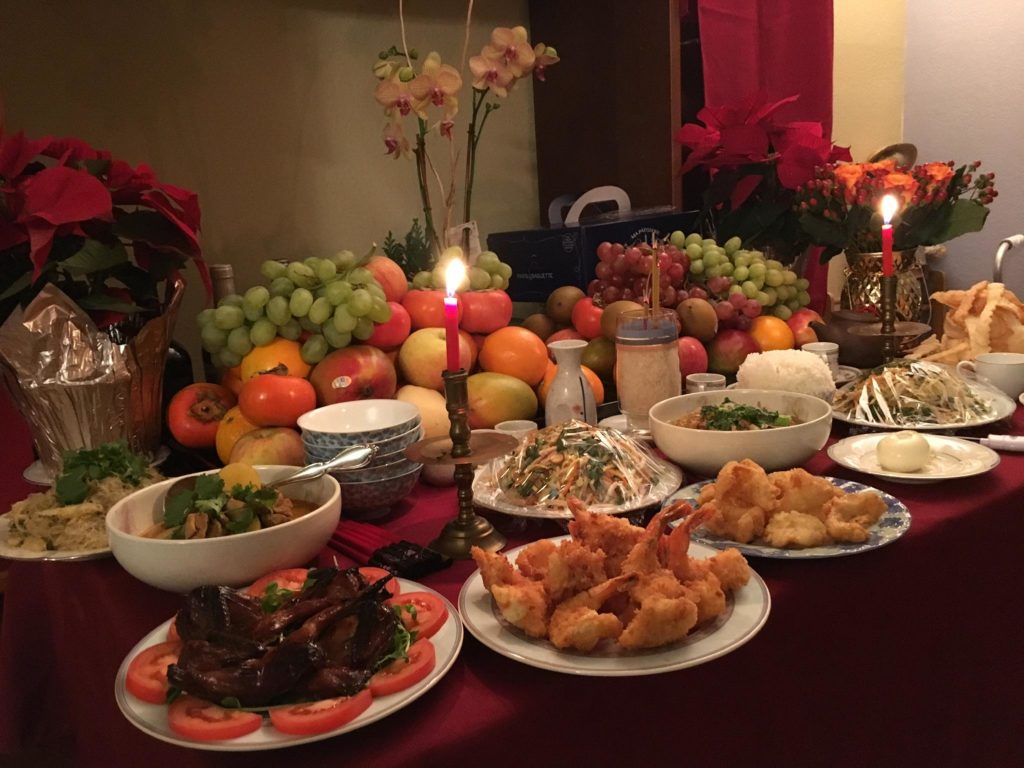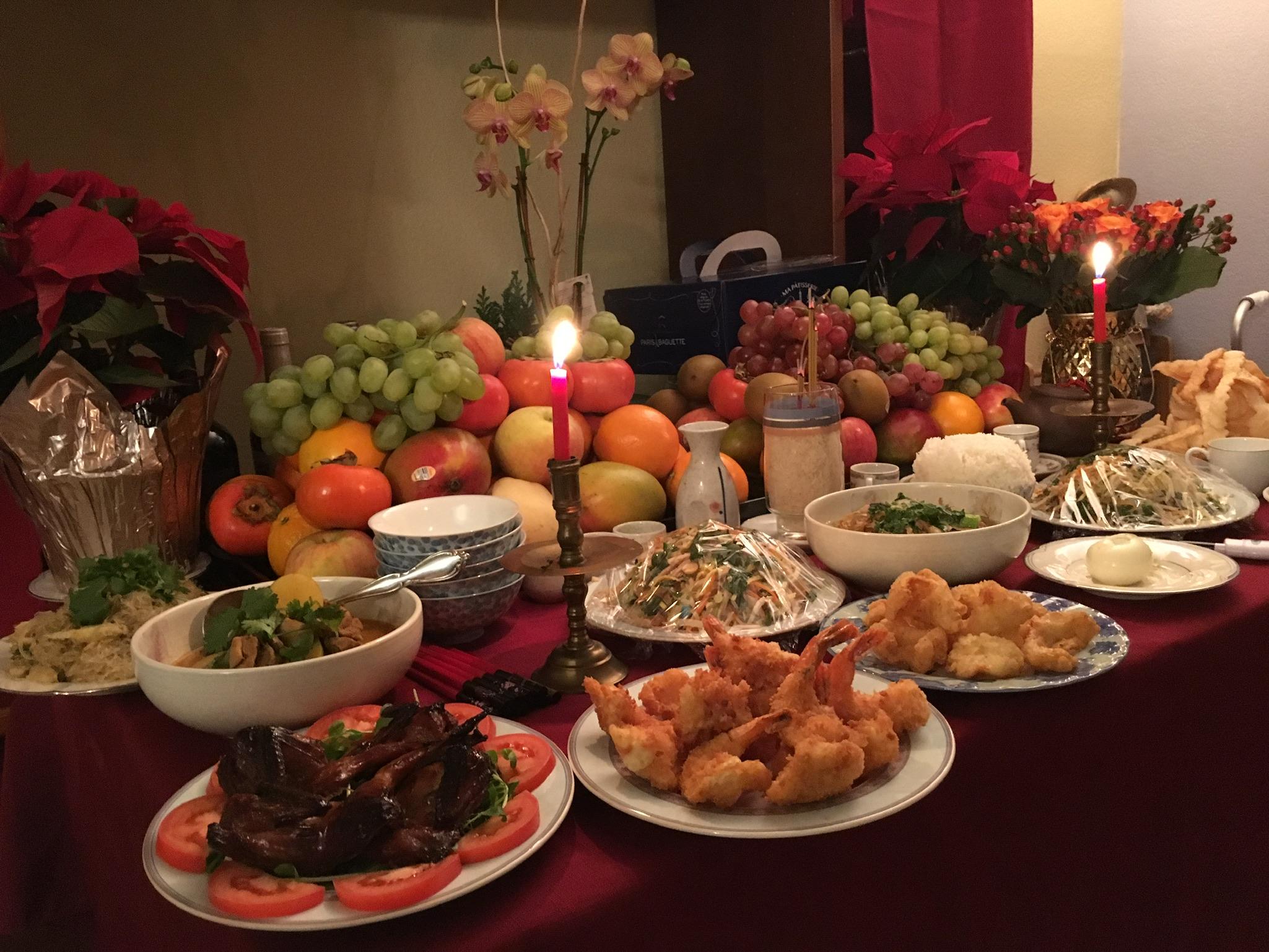By Christine Nguyen, MD. This story originally appeared on KALW FM’s “Crosscurrents.”

Food for grandmother at the family altar. (Photo courtesy of Christine Nguyen)
In 2006, my Mom had a dream. Grandma sat above her, perched on a black stone wall so high her feet didn’t touch the floor. “Mother,” Mom called, “You’re up so high. You might fall to your death.”
A phone call interrupted Mom’s dream. It was her brother. Their mother was dead. “Sister,” he added, “I’ve made Mother a tombstone. Black. Granite from India.”
Ancestor worship is the most common religious practice in Vietnam. It’s called Đạo Ông Bà, or “belief in Grandfather and Grandmother.” When a Vietnamese parent dies, the children make an altar in their homes for the parent’s spirit to live. The practice is common to Buddhists, Catholics and adherents of other religions. Respect and worship of elders are universal.
Vietnamese living in the United States have had to modify some funeral customs to accommodate western sensibilities. My family did not bury Grandmother in the garden. We didn’t exhume her bones three years later, clean them, and rebury them in a permanent shrine, as might happen in Vietnam. We settled for a plot in a cemetery. But we did acknowledge Grandma’s unassailable position in our family.
Her monument was made to her very rigid specifications. In the cemetery, her monument’s glossy slabs of black polished granite are unmistakable in a grid of gray headstones. Steps lead to a platform. Her casket lies underneath and is angled so that her head and feet point in the most auspicious directions. It’s set up to honor her wishes. No grass will ever grow over her. Grandma always hated the idea of people stepping on her body after she died. “If anyone steps on my back,” she warned, “I’ll break their neck!”
Spirits of a Family’s Future
Vietnamese believe the parent’s spirit can control the family’s future. Throughout the year, at the family altar, the spirit is offered fruit, rice, water and tea. It’s not uncommon to see a can or two of Heineken. Some families may burn paper money, or more recently, fake mobile phones for the spirits to live comfortably in the afterlife. Without the offerings, the spirit becomes a “hungry ghost,” that haunts the family.
Rituals are an important part of understanding the life and death process. We light incense daily as a reminder that life burns shorter and shorter. Flowers on the altar represent the temporary beauty of life. Then, every year at the đám giỗ, or death feast, the dead and living members of the family are bound in an interdependent relationship. We take care of them, they take care of us.
On the day of my grandmother’s death feast, my aunt Mười explains that we must hold our deceased elders close. “The bàn thờ, the ancestor altar, you always put in the family room. It has the warmth,” she says. “So the dead, people still can join you.” She then pauses. “Hope they don’t–but still,” she adds with a laugh.
Aunt Mười was my grandmother’s tenth child. She shared a bed with her mother. Even now, at 64 years old, Aunt Mười remembers the comfort her mother’s solid presence gave her. When I ask her about her childhood memories of her mother, she looks as if she’s peering into a distance and explains that even when she was in college, she still needed her mother’s security.
“I still sleep in the same bed with her. And my memory of childhood is I wake up in the middle of the night, I always touch her, make sure she still alive.” Her voice cracks as the years peel back to reveal that young woman. “I still miss her…I still miss her. She’s one of a kind. None of us can follow her.”
I also remember sleeping on that bed as a kid. It was a carved rosewood table with no pillows. Turning periodically to find a comfortable position, I wondered if my head would mold into a square shape from sleeping on such a hard surface. The bed echoes the family altar, which is traditionally also made of carved rosewood.
In Vietnam, female family members do much of the work for the death feast. They spend days preparing the grandparent’s favorite dishes. But things are different in our family. My aunt Mười is making sautéed crab with clear thread noodles. But it’s her husband’s job to crack the crab.
How did my uncle become the official crab cracker? Meditatively, my uncle explains, “Patience.” Aunt Mười pipes in with a more mundane answer. “Because the wife doesn’t do it!” she says with a cackle.
Death Celebration a ‘Time to Heal’
Joking aside, for Aunt Mười, the đám giỗ, the death celebration, helps maintain family relationships after a parent dies. She reflects on the origins of death anniversaries while salting and washing a chicken.
“When the parents pass away, the children scatter. There’s no place for the children to come together anymore. That’s why the Vietnamese people want to celebrate the death anniversary. So they can bring all the children back together.”
She adds that family relationships can be complex. “Or if the family is mad at each other, it’s a time to heal. To be one family again. Is that amazing? That’s very thoughtful. Very deep and thoughtful! We never have a birthday party. The Vietnamese don’t even remember their birthday, but they remember the dead.”
Once everyone arrives for the party, my oldest uncle calls Grandmother’s spirit to come eat. There’s a big spread. Grandma’s picture presides over her own platters of fruit. Always, she also has a bowl of rice, a boiled egg and a cup of water. Grandma wasn’t a heavy drinker, but there’s a small carafe of rice wine and a few bottles. We leave her huge portions of curry, fried shrimp and squid, sautéed noodles, prawn chips, bamboo soup, spring rolls, green papaya salad and grilled quail to enjoy while we eat our own food. As we eat, everyone critiques the food they’ve made for the woman who never even learned to cook rice.
It’s actually a lively event, this party with a dead guest of honor. But everyone is older now. Aunt Mười, the youngest of Grandma’s children is 64. My generation has taken over the “big table,” but we still call it the “kids table,” even if we have our own kids. The “grownups” squish into folding tables, but they still claim the most comfortable chairs. They predict the “kids” won’t follow the old customs. A recurrent joke every year is, “You know, I’m going to go hungry in the afterlife.”
But for now, most of us are here, sharing stories about Grandma. She was a tenacious survivor. At 4 foot 8 inches, she was diminutive even by Vietnamese standards. She lost her right eye to an infection as a child and was considered unmarriageable. So she worked in the rice fields to make her own money to buy and sell land and goods. She eventually even acquired her own parents’ best farmland.
Escaped Death Squads
After having each of her 10 children, Grandma went right back to work, hiring rural women to physically carry and nurse the children. After 1954, when the French ceded all of Vietnam, she evaded communist Viet Minh death squads who viewed landowners like her as enemies of the people.
Aunt Mười, explains, “The Viet Minh went to Hanoi and look for her and bring her back to the village. Even they bury some people alive.” But not Grandmother. With a million other North Vietnamese, Grandmother and Grandfather fled to the south.
In their new home in Saigon, Grandma made the rules. Aunt Mười says Grandma expected as much housework from her five boys as her five girls. “The girls cook. The boys wash the clothes–and mop the floor. And when they wash the clothes, they wash everything. Not like, don’t wash underwear. They wash everything.”
Grandma set the standard for the formidable women in my family. “She is a women’s rights activist!” Muoi elaborates, “She grew up in a generation in which women not allowed to go to school. She learned how to read and write by looking over the brother’s shoulder. Yes, my mother is one of a kind. And today we celebrate her death.”
12 Years Later
It’s now twelve years since my Grandmother died, and my mother is still having that dream with Grandma teetering on the black wall. Mom’s never gone to Grandma’s đám giỗ, the death celebration. She’s afraid of her mother’s ghost. So I take her on a clear winter day to make amends with the ghost. It is only the second time my mom has been to the cemetery where her mother is buried.
“I’ve come to visit you Mother,” Mom chokes as she fumbles with the bouquets she’s brought.
She arranges the red and yellow flowers in vases and pours in the distilled water she’s specially bought. “Your flowers are very beautiful Mother. It’s been very long since I’ve come to visit you. Don’t forget, be strong and healthy”
She traces the letters of her mother’s name with her fingers. Then she leans on the steps, steadying herself, picking off leaves and sweeping the stone with her hands.
“None of the tombstones are as beautiful as hers,” she conspiratorially whispers to me.
“Grandma used to grumble, “I hate it. Here in America when you die, you just lie around–all over the ground.” So here they’ve built a structure you’d have to climb to stand over her. “Your house is the most beautiful, Mother. No one else’s is so shiny and black.” She stands, ruminating about how fearsome Grandmother is. “Okay, I’m going home Mother. Keep us healthy.” Mom stops her tears as quickly as they started, “Let’s go.”
As we leave, Mom instructs me to respect the other ghosts. “See,” she explains, “Here, we could walk on someone’s neck. Let’s go this way so maybe we don’t step on anyone.”
The first time I took Mom to Grandma’s cemetery, I saw my mother in a new light. She was indestructible like Grandmother, but also a child. She was more human and more beautiful than I had ever seen her. And to see her like that made me love her more than ever before. Like the generations before me, I can never repay my debt to my mother. And whatever Western values I have acquired, that’s one way of thinking I never want to change.
When we leave, Mom wants to take a detour. “Don’t go straight home,” she tells me. “Grandma’s ghost is strong. It may end up in the house.” So we go to Target. Even Grandma can’t catch us in an American personal-care aisle.
I can’t tell you that this is a Vietnamese tradition because it’s not. An uncle said, “I’ve never heard of this custom of dodging Grandmother’s spirit in a shopping mall.” No, it’s something new Mom and I have created to give her some peace.
Christine Nguyen, MD, produced this story for KALW public radio’s “Crosscurrents”with the support of a journalism fellowship from the Gerontological Society of America, Journalists Network on Generations and the Silver Century Foundation.
The opinions expressed in this article are those of the author and do not necessarily reflect those of the Diverse Elders Coalition.

